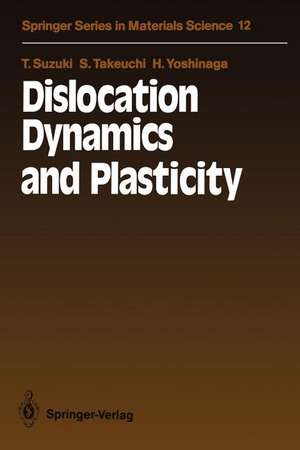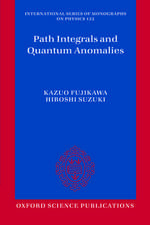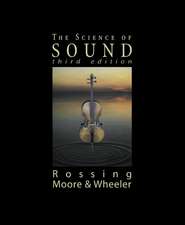Dislocation Dynamics and Plasticity: Springer Series in Materials Science, cartea 12
Autor Taira Suzuki, Shin Takeuchi, Hideo Yoshinagaen Limba Engleză Paperback – 23 dec 2011
Din seria Springer Series in Materials Science
- 18%
 Preț: 1820.22 lei
Preț: 1820.22 lei - 18%
 Preț: 776.09 lei
Preț: 776.09 lei - 24%
 Preț: 689.69 lei
Preț: 689.69 lei - 18%
 Preț: 968.96 lei
Preț: 968.96 lei - 20%
 Preț: 568.95 lei
Preț: 568.95 lei - 18%
 Preț: 953.65 lei
Preț: 953.65 lei - 18%
 Preț: 902.36 lei
Preț: 902.36 lei - 18%
 Preț: 953.65 lei
Preț: 953.65 lei - 20%
 Preț: 948.42 lei
Preț: 948.42 lei - 18%
 Preț: 1143.07 lei
Preț: 1143.07 lei - 18%
 Preț: 1111.53 lei
Preț: 1111.53 lei - 18%
 Preț: 1103.62 lei
Preț: 1103.62 lei - 18%
 Preț: 1225.94 lei
Preț: 1225.94 lei -
 Preț: 473.91 lei
Preț: 473.91 lei - 18%
 Preț: 782.42 lei
Preț: 782.42 lei -
 Preț: 433.47 lei
Preț: 433.47 lei - 18%
 Preț: 1116.40 lei
Preț: 1116.40 lei - 18%
 Preț: 946.24 lei
Preț: 946.24 lei - 18%
 Preț: 945.20 lei
Preț: 945.20 lei - 18%
 Preț: 1114.21 lei
Preț: 1114.21 lei - 15%
 Preț: 641.20 lei
Preț: 641.20 lei - 18%
 Preț: 958.56 lei
Preț: 958.56 lei - 18%
 Preț: 1224.36 lei
Preț: 1224.36 lei - 15%
 Preț: 644.82 lei
Preț: 644.82 lei - 24%
 Preț: 833.45 lei
Preț: 833.45 lei - 24%
 Preț: 1060.36 lei
Preț: 1060.36 lei - 18%
 Preț: 964.10 lei
Preț: 964.10 lei - 18%
 Preț: 1224.36 lei
Preț: 1224.36 lei - 18%
 Preț: 1221.20 lei
Preț: 1221.20 lei - 18%
 Preț: 946.87 lei
Preț: 946.87 lei - 18%
 Preț: 1836.92 lei
Preț: 1836.92 lei - 15%
 Preț: 643.34 lei
Preț: 643.34 lei - 18%
 Preț: 1246.32 lei
Preț: 1246.32 lei - 18%
 Preț: 956.81 lei
Preț: 956.81 lei - 18%
 Preț: 953.52 lei
Preț: 953.52 lei - 15%
 Preț: 637.59 lei
Preț: 637.59 lei
Preț: 468.44 lei
Preț vechi: 551.10 lei
-15% Nou
Puncte Express: 703
Preț estimativ în valută:
89.65€ • 93.25$ • 74.01£
89.65€ • 93.25$ • 74.01£
Carte tipărită la comandă
Livrare economică 14-28 aprilie
Preluare comenzi: 021 569.72.76
Specificații
ISBN-13: 9783642757761
ISBN-10: 3642757766
Pagini: 244
Ilustrații: X, 228 p.
Dimensiuni: 155 x 235 x 13 mm
Greutate: 0.35 kg
Ediția:Softcover reprint of the original 1st ed. 1991
Editura: Springer Berlin, Heidelberg
Colecția Springer
Seria Springer Series in Materials Science
Locul publicării:Berlin, Heidelberg, Germany
ISBN-10: 3642757766
Pagini: 244
Ilustrații: X, 228 p.
Dimensiuni: 155 x 235 x 13 mm
Greutate: 0.35 kg
Ediția:Softcover reprint of the original 1st ed. 1991
Editura: Springer Berlin, Heidelberg
Colecția Springer
Seria Springer Series in Materials Science
Locul publicării:Berlin, Heidelberg, Germany
Public țintă
ResearchCuprins
1. Dislocations and Their Fundamental Properties.- 1.1 Geometry of a Dislocation.- 1.2 Stress Field and Energy of Dislocations.- 1.3 Force on a Dislocation.- 1.4 String Model of a Dislocation.- 1.5 Obstacles to Dislocation Motion.- 2. Motion of Dislocations in Soft Metals.- 2.1 General Characteristics.- 2.2 Intrinsic and Extrinsic Barriers for the Motion of Dislocations.- 2.3 Dislocation Velocity.- 2.4 Frictional Forces due to Conduction Electrons and Phonons.- 2.5 Theoretical Studies of the Frictional Forces.- 3. Dislocation Motion in the Field of a Random Distribution of Point Obstacles: Solution Hardening.- 3.1 Solution Hardening.- 3.2 Comparison of Theories of Solution Hardening with Computer Simulation.- 3.3 Effect of a Random Distribution of Point Obstacles on ?c.- 3.4 Appendix: Elastic Interaction Between a Dislocation and a Solute Atom.- 4. Dislocation Dynamics and Strength of Crystalline Materials.- 4.1 The Loss of Strength of Metals and Alloys in the Superconducting State.- 4.2 Loss of Strength in the Normal State of Solid Solutions at Low Temperatures.- 4.3 Theory of Inertial Effects.- 4.4 Quantitative Treatment of the Strength of Metals and Alloys of fcc Structure.- 5. Dislocation Motion Controlled by the Peieris Mechanism.- 5.1 Introduction.- 5.2 Dislocation Glide by the Peieris Mechanism.- 6. Dislocations in bcc Metals and Their Motion.- 6.1 Dislocations in bcc Metals and Their Peierls Potential.- 6.2 Computer Experiments.- 6.3 Plasticity of bcc Metals.- 7. Dislocation Motion in Semiconducting Crystals.- 7.1 Introduction.- 7.2 Structure of Dislocations in Semiconducting Crystals.- 7.3 Mobility of Dislocations in Semiconducting Crystals.- 7.4 Effect of Electronic Excitation on the Dislocation Mobility.- 7.5 Photoplastic Effect in II-VI Compounds.- 8.High-Temperature Deformation of Metals and Alloys.- 8.1 Deformation Mechanism Map.- 8.2 Deformation due to Dislocation Motion.- 8.3 Identification of Deformation Mechanism at High Temperatures.- 9. High-Temperature Deformation Mechanism in Metals and Alloys.- 9.1 High-Temperature Deformation Mechanism in Pure Metals.- 9.2 High-Temperature Deformation Mechanism in Alloys.- 10. High-Temperature Deformation Mechanism in Composite Materials.- 10.1 Types of Composite Materials.- 10.2 High-Temperature Deformation Mechanism in Dispersion-Strengthened Materials.- 10.3 High-Temperature Deformation Mechanism in Fiber- and Lamella-Reinforced Materials.- References.














